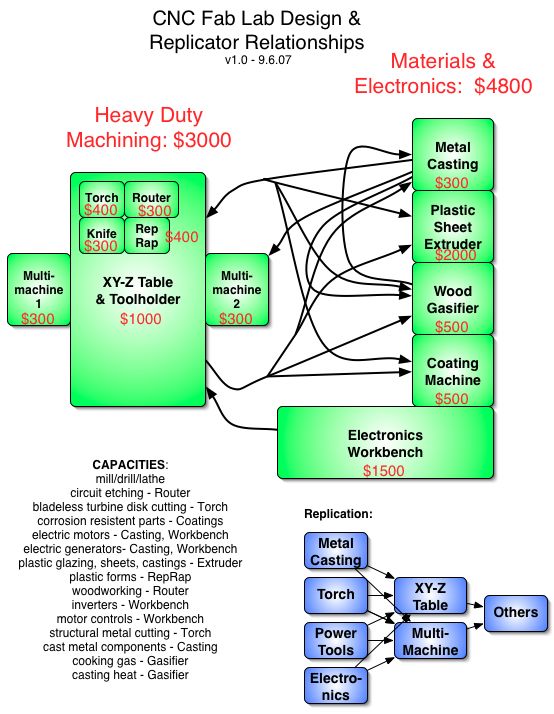Replication/Archive
Note: this is an archive, which is not up-to-date with the Replication page.
Replication Strategy
Advance working prototypes into production
Contact True Fans, Gaia University, The Farm, and other potentates and Collaborators to focus on refining current prototypes to market and resell, like LifeTrac and The Liberator, to fund Factor e Farm and our partner organizations and individuals. An applied Open Business Model will help put products into action and fund Factor e Farm and our partners to help accelerate the assembly of the Global Village Construction Set. For a business plan outline view Network, Optimize, and Replicate. Also view neocommercialization, the foundation for open business models.
Replication-in-Focus
- What tools are used?
- What materials are needed and where are they optimally located?
- How are parts assembled, from start to finish, A to Z?
- The rationale for decisions made as needed.
Step-by-Step Assembly Instruction
Document how parts are assembled in detail (e.g. weld Widget A to Widget B). This makes use of written and verbal language, CAD graphics, and video footage.
Tool Location
Collaborators list on a product wiki tools to lend or donate by geographical region. They may be sold for less than Industrial retailers. Trade agreements can be made (e.g. Tool for Materials, Materials for Finished Product, ect). Lending or donating is most preferred. Logs detail donations and exchanges.
Materials Location
Collaborators list on product wiki by geographical region the most optimal materials locations with retrieval information. Materials possessed by a collaborator can be given for free or a fee lower than competing Industrial retailers. Trade agreements can be made (e.g. Materials for Tools, Materials for Finished Product, ect). Lending or donating is most preferred. Logs detail donations and exchanges.
Step 1. Replicate the Workspace
We can begin by replicating the FlexFab Workshop itself. This is essential for a learner to more easily replicate each product. Explain what is needed in a workshop environment with instructions on how to construct the workshop and acquire or build the manufacturing tools.
When production begins an additional workshop environment will be needed at either Factor e Farm or another location. This is to have a workshop available at all times for development of GVCS prototypes and other research and creative endeavors.
Learn by Viewing & Doing
In a video format show from beginning to end the construction of a product. The goal is to transfer the knowledge of how to construct each tool with no prior experience to a young child. This assumes we live in a world of young children.
Scenario Example
With the help of avid knowledge and financial support, Collaborators on the web, Nick, Jeremy, Marcin, and the Core Team successfully construct the final prototype of the Solar Power Generator and are now ready to share construction knowledge with a student and the world simultaneously. Nick wants to share his knowledge, so he becomes an instructor while Marcin, Jeremy, and the Core Team work with Collaborators to continue developing prototypes for GVCS.
Like the viewer, the student has little knowledge of the product design before it is built. This is very helpful for both the student and the viewer! Dialogue between instructor and student is recorded with special attention to 1) what tools are used, 2) what materials are needed and where they are optimally located, 3) how parts are assembled, from start to finish, A to Z, and 4) the rationale for decisions made as needed.
All activity is video recorded. The director's role is to understand and present how to assemble the design. This will mean at least two individuals, the film director and the student will learn how to assemble the design before the document is published. Close-up footage with a voice over are used to describe "widget A assembled to widget B." Assembly knowledge is crucial to technical knowledge transfer used for construction. Ensure the presentation is condensed and refined in a manner a small child can understand. In a matter of days the footage is edited and published.
Some time later, the audio is transcribed and copied to a wiki page and included as optional subtitling. The transcript is translated, perhaps cooperatively, into other languages. The translated subtitles are read out loud with a different voice-over for each language that joins in.
Video is uploaded to YouTube and linked from the Solar Power Generator wiki. It is also available on video disc. Included are listings of required tools and materials locations sited by geographical region. Now potentially anyone in the world can build an energy source to power a small community. Inter-independence is the result!
